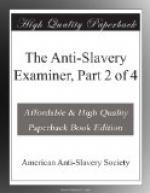The Moravian chapel was slightly decorated with green branches. They were the only adorning which marked the plain sanctuary of a plain people. It was crowded with black and colored people, and very many stood without, who could not get in. After the close of the service in the chapel, the minister proceeded to the adjacent school room, and preached to another crowded audience. In the evening the Wesleyan chapel was crowded to overflowing. The aisles and communion place were full. On all festivals and holidays, which occur on the Sabbath, the churches and chapels are more thronged than on any other Lord’s day.
It is hardly necessary to state that there was no instance of a dance or drunken riot, nor wild shouts of mirth during the day. The Christmas, instead of breaking in upon the repose of the Sabbath, seemed only to enhance the usual solemnity of the day.
The holidays continued until the next Wednesday morning, and the same order prevailed to the close of them. On Monday there were religious services in most of the churches and chapels, where sabbath-school addresses, discourses on the relative duties of husband and wife, and on kindred subjects, were delivered.
An intelligent gentleman informed us that the negroes, while slaves, used to spend during the Christmas holidays, the extra money which they got during the year. Now they save it—to buy small tracts of land for their own cultivation.
The Governor informed us that the police returns did not report a single case of arrest during the holidays. He said he had been well acquainted with the country districts of England, he had also travelled extensively in Europe, yet he had never found such a peaceable, orderly, and law-abiding people as those of Antigua.
An acquaintance of nine weeks with the colored population of St. John’s, meeting them by the wayside, in their shops, in their parlors, and elsewhere, enables us to pronounce them a people of general intelligence, refinement of manners, personal accomplishments, and true politeness. As to their style of dress and mode of living, were we disposed to make any criticism, we should say that they were extravagant. In refined and elevated conversation, they would certainly bear a comparison with the white families of the island.
VISIT TO THIBOU JARVIS’S ESTATE.
After the Christmas holidays were over, we resumed our visits to the country. Being provided with a letter to the manager of Thibou Jarvis’s estate, Mr. James Howell, we embraced the earliest opportunity to call on him. Mr. H. has been in Antigua for thirty-six years, and has been a practical planter during the whole of that time. He has the management of two estates, on which there are more than five hundred people. The principal items of Mr. Howell’s testimony will be found in another place. In this connection we shall record only miscellaneous statements of a local nature.




